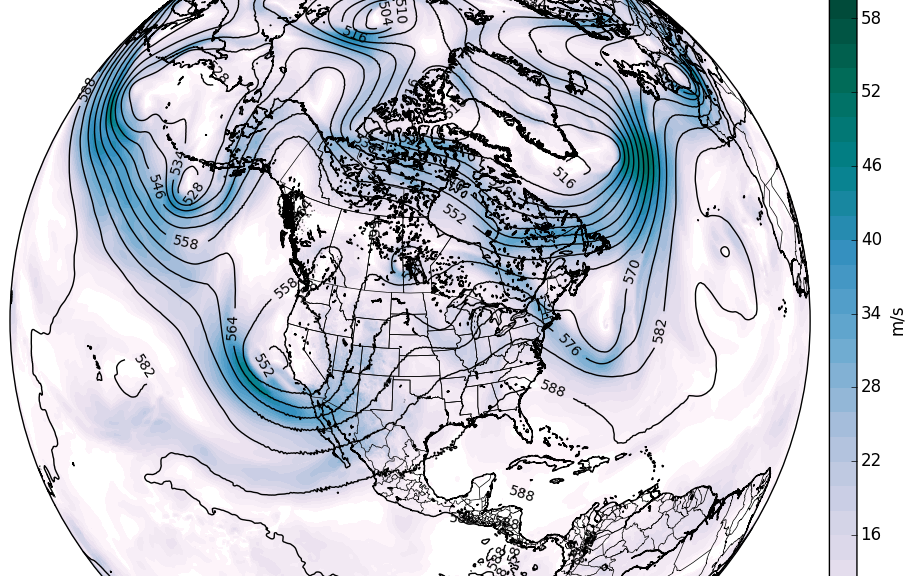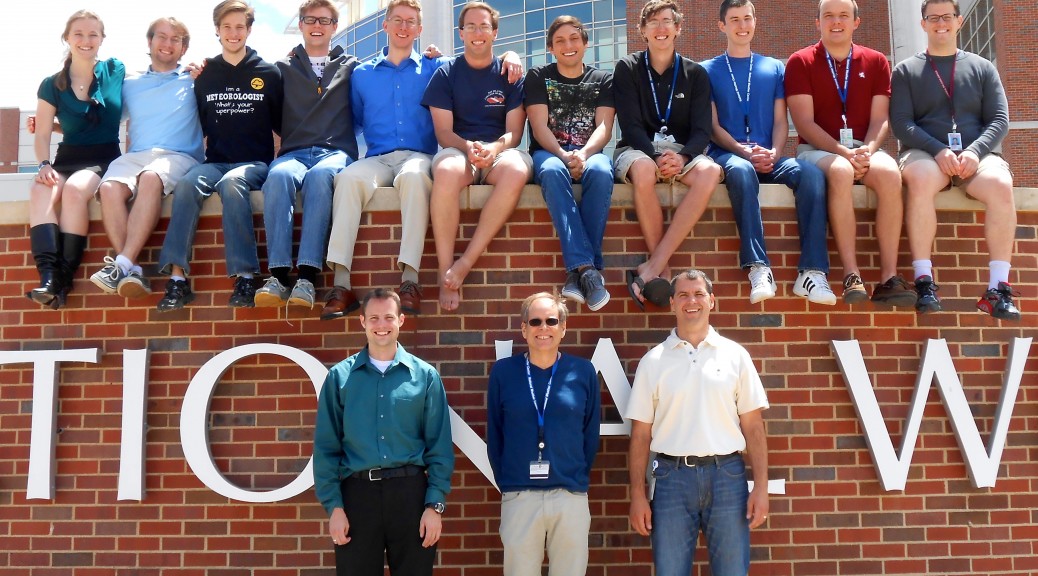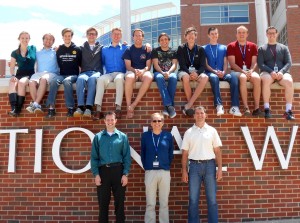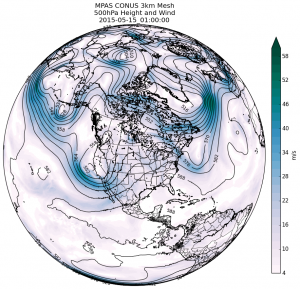Prof. Cavallo and the AAARG research group will be studying Arctic cyclones with a new grant entitled “Polar Predictability and Dynamics through Multi-scale Atmospheric Vortices.” See this press release or contact us for more info!
Category Archives: News
3 student graduations!
Congratulations to the following AAARG students!
Dr. Ariel Cohen, who successfully defended his Ph.D. dissertation “Southeast U.S. cold season severe thunderstorm environments and their depictions using multiple planetary boundary layer parameterization schemes” (adviser: Prof. Steven Cavallo).
Chris Riedel, who successfully defended his M.S. thesis “Improved characterization and prediction of Antarctic weather through ensemble data assimilation and utilization of the concordiasi data set” (adviser: Prof. Steven Cavallo).
Ben Blake, who succesfully defended his M.S. thesis “The structure, evolution and dynamics of a nocturnal convective system simulated using the WRF-ARW model (adviser: Prof. David Parsons)

05/04/2015: Model for the Prediction Across Scales (MPAS) goes real-time for the 2015 Hazardous Weather Testbed Spring Experiment
The NOAA Hazardous Weather Testbed’s 2015 Spring Experiment will include global MPAS forecasts for the first time ever! Simulations are initialized daily from GFS at 00 UTC. MPAS is a variable-resolution global mesh, with cell spacing ranging from 3-km over the Continental United States with a smooth transition to 50-km elsewhere around the globe. It includes a “scale aware” convective parameterization. Animations can be found at:
http://www.wrf-model.org/plots/realtime_mpasconv.php
This project is made possible through a collaborative effort between Dr. Steven Cavallo at the University of Oklahoma, Dr. Louis Wicker of NSSL, Dr. William Skamarock of NCAR, and Dr. Adam Clark of NSSL.
Coming soon, we will provide exciting animations on the globe!
4/28/2015: New NSF grant awarded to Dr. Steven Cavallo and Dr. Dave Turner!
NATIONAL SCIENCE FOUNDATION
4201 WILSON BOULEVARD, ARLINGTON, VA 22230
OFFICE OF LEGISLATIVE AND PUBLIC AFFAIRS
Award Date: Apr. 28, 2015
Award No.: 1461838
We are pleased to notify you regarding a recent National Science Foundation (NSF) award made to University of Oklahoma Norman Campus with an intended total amount of $298,112.00.
This project, entitled “Sensitivity of the midlatitude waveguide to the dynamics and observations of Arctic tropopause-based vortices,” is under the direction of Steven Cavallo. The award starts Aug. 01, 2015.
The abstract and other information regarding this award will soon be publicly available via the NSF Award Abstracts database at http://www.nsf.gov/awardsearch/showAward.do?AwardNumber=1461838 .
Any questions regarding this notification should be addressed to NSF’s Office of Legislative and Public Affairs at 703-292-8070.
01/20/2015: AAARG undergraduate student Kelton Halbert leads National Weather Center team awarded best student poster
Kelton Halbert and Greg Blumberg both of the School of Meteorology and Patrick Marsh of NOAA’s Storm Prediction Center were awarded best student poster at the 5th Symposium on Advances on Modeling and Analysis Using Python. Congratulations to the authors, especially to Kelton Halbert, since he is a sophomore competing against mostly MS and PhD students. Kelton volunteers for the Oklahoma Weather Laboratory and works supporting research under Dr. Steven Cavallo within the Antarctic And Arctic Research Group (AAARG).

Welcome to AAARG
 Our lab’s research focuses on the dynamics and physical mechanisms of high latitude atmospheric processes. We study Arctic and Antarctic processes using high resolution regional and global numerical models such as NCAR’s Weather Research and Forecasting (WRF) model and the Model for the Prediction Across Scales (MPAS). Since these locations are relatively data-sparse regions of the globe, we also study atmospheric predictability through ensemble data assimilation techniques using tools such as the Data Assimilation Research Testbed (DART) to better understand how to extend information provided by observations to improve numerical models. Some of the primary scientific applications are described below.
Our lab’s research focuses on the dynamics and physical mechanisms of high latitude atmospheric processes. We study Arctic and Antarctic processes using high resolution regional and global numerical models such as NCAR’s Weather Research and Forecasting (WRF) model and the Model for the Prediction Across Scales (MPAS). Since these locations are relatively data-sparse regions of the globe, we also study atmospheric predictability through ensemble data assimilation techniques using tools such as the Data Assimilation Research Testbed (DART) to better understand how to extend information provided by observations to improve numerical models. Some of the primary scientific applications are described below.
Tropopause polar vortices (TPVs): TPVs are coherent vortices that are based on the tropopause in higher latitude regions. Higher latitudes are a unique environment for their maintenance due to colder temperatures and relatively low latent heating rates, allowing radiative processes to dominate. Once TPVs exist, a characteristic downward intrusion of dry air results in an increase in longwave radiative cooling inside the vortex.
Since TPVs are often isolated from the jet stream, they can have long lifetimes over the Arctic—sometimes on the order of months! Lifetimes are especially long during the summer. We are currently examining how they interact with sea ice, since during the winter reductions in sea ice can increase latent heating and during the summer TPVs can more easily advect the thin or broken sea ice over the Arctic.
Midlatitude interactions: Motivation to better understand TPVs derives from the need to improve predictability in middle latitudes from weather to climate scales. TPVs are characterized by an upper-level potential vorticity anomaly that are important dynamical features needed in order for surface cyclones to generate. An understanding of their interactions with midlatitude weather is not well understood, and therefore a better understanding of TPVs could ultimately lead to improvement in the forecasting of major events such as snowstorms, severe weather, sea ice, and extratropical transitions.
Antarctic ensemble data assimilation: Our group utilizes ensemble data assimilation techiques to help build our understanding of the processes that are represented in numerical models and improve the capability of numerical weather prediciton. The Antarctic is of particular interest to our group since it is the most data sparse region of the globe. We are currently working on methods to best assimilate the observations that we do have in order to improve weather and climate prediction.
Arctic cloud/atmosphere/surface interactions: There are many atmospheric processes that link together cloud properties, the thermodynamic state, turbulence, radiation, and ultimately surface properties in the Arctic environment. The Integrated Characterization of Energy, Clouds, Atmospheric state, and Precipitation at Summit (ICECAPS) project is collecting a comprehensive dataset in the center of the Greenland Ice Sheet that is being used to investigate these processes and improve the ability to model cloud and precipitation above Greenland.
